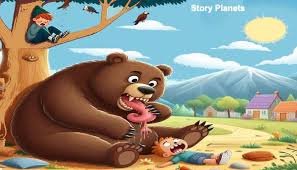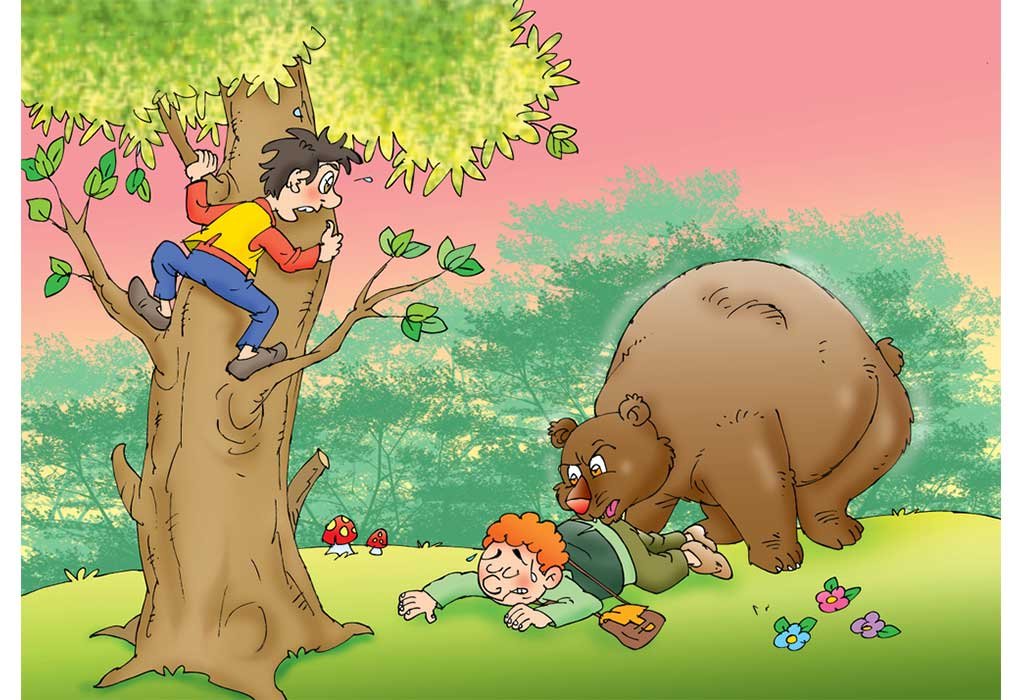The ancient fable of The Two Friends & the Bear presents one of humanity’s most enduring tests of character, a story so fundamental to our understanding of loyalty that variations appear in nearly every world culture. While commonly attributed to Aesop, the tale actually predates Greek civilization, with similar stories found in ancient Indian Panchatantra texts and indigenous North American folklore. The classic version follows two travelers walking through a forest when suddenly confronted by a bear – one friend immediately climbs a tree in panic, abandoning the other, who drops to the ground pretending to be dead. As the bear sniffs the “corpse” and wanders away (bears rarely eating carrion, a detail modern zoologists confirm), the cowardly friend descends asking what the bear whispered. The response – “Never trust a friend who deserts you in danger” – delivers the story’s moral punch. What most retellings omit is the fascinating historical context: in original Greek versions, the friends were Spartan soldiers testing each other’s battlefield loyalty, while medieval European adaptations framed them as merchant apprentices traveling dangerous trade routes. The bear itself carries symbolic weight across cultures – in Siberian versions it’s a shape-shifting spirit testing human integrity, while in Japanese folklore the creature becomes a metaphorical “mountain ogre” representing life’s unexpected crises.
Psychological analysis reveals deeper layers to this simple tale. The two friends represent primal human responses to threat – fight (standing together), flight (abandoning), or freeze (playing dead) – making the story a natural lesson in emotional intelligence. Modern relationship experts note how the fable perfectly illustrates John Gottman’s “Four Horsemen” theory of relationship failure, where abandonment during stress predicts friendship dissolution. The forest setting, often overlooked, serves as a liminal space – a transitional zone where social masks fall away and true character emerges, much like Joseph Campbell’s hero’s journey archetype. Neuroscientists might interpret the surviving friend’s quick thinking as demonstrating prefrontal cortex control over amygdala-driven panic, while the deserter exemplifies failed stress response modulation.
Historically, the fable served practical purposes beyond moral instruction. Viking leaders reportedly used bear encounter stories to test crew loyalty before sea voyages, while 18th century European guilds included it in apprentice oaths to emphasize trade brotherhood. The story’s most controversial adaptation appeared during the American Civil War, where abolitionists recast it as a parable about Northern allies abandoning slaves, with the bear representing institutional oppression. This flexibility explains its endurance – the core conflict adapts seamlessly to any era’s social tensions. Even the bear’s behavior reflects cultural attitudes: Middle Eastern versions feature the animal mauling the deserter (emphasizing punishment), while Buddhist retellings have it sparing both friends (highlighting mercy’s power).

Modern applications abound in surprising fields. Corporate trainers use the fable to discuss workplace loyalty during layoffs, relationship coaches employ it to identify “fair-weather friends,” and survival instructors cite it when teaching crisis decision-making. The military still references the story in leadership courses – West Point’s version substitutes a landmine for the bear. Silicon Valley has co-opted the metaphor, with startup culture distinguishing “ride-or-die” co-founders from those who “bail when the VCs come.” Social media analysts even see parallels in online behavior – the “friend” who disappears during a controversy versus those who stand by during “cancel culture” attacks.
The characters’ minimalism makes them powerful archetypes. The loyal friend demonstrates situational awareness and emotional control – their “playing dead” represents the wisdom to sometimes yield rather than confront. The deserter isn’t purely villainous but humanly flawed, embodying our universal fear response. Even the bear plays a vital role as nature’s impartial judge, testing bonds no human court could assess. This symbolic richness explains the story’s cross-cultural persistence: Nigerian versions make the friends market rivals, Tibetan renditions frame them as monk and disciple, while Arctic indigenous tellings replace the bear with a blizzard.
Scientific insights validate the fable’s premise. Studies on war veterans and emergency responders confirm that crisis bonds either strengthen relationships or reveal their fragility. Anthropological research shows hunter-gatherer groups who shared food during famines (the “loyal friend” model) survived better than those with “every person for themselves” attitudes. Even in wildlife biology, analogous behavior appears – certain bird species warn companions of predators while others flee silently.
What makes The Two Friends & the Bear truly timeless is its rejection of easy moralizing. Unlike fables where villains get punished, here the deserter faces no physical comeuppance – the real consequence is eroded trust, a subtler but more profound loss. The story understands that true tests of character aren’t about dramatic sacrifices but split-second choices revealing established patterns. In an age of superficial digital connections, this ancient tale reminds us that real friendship isn’t measured in shared laughs but in who remains standing when life’s bears appear – making its lesson perpetually urgent. Whether applied to childhood friendships, business partnerships, or societal solidarity, the fable’s message endures: trust is the one thing we can’t afford to lose, and the only way to keep it is to prove worthy when others need us most.
Go to main page


